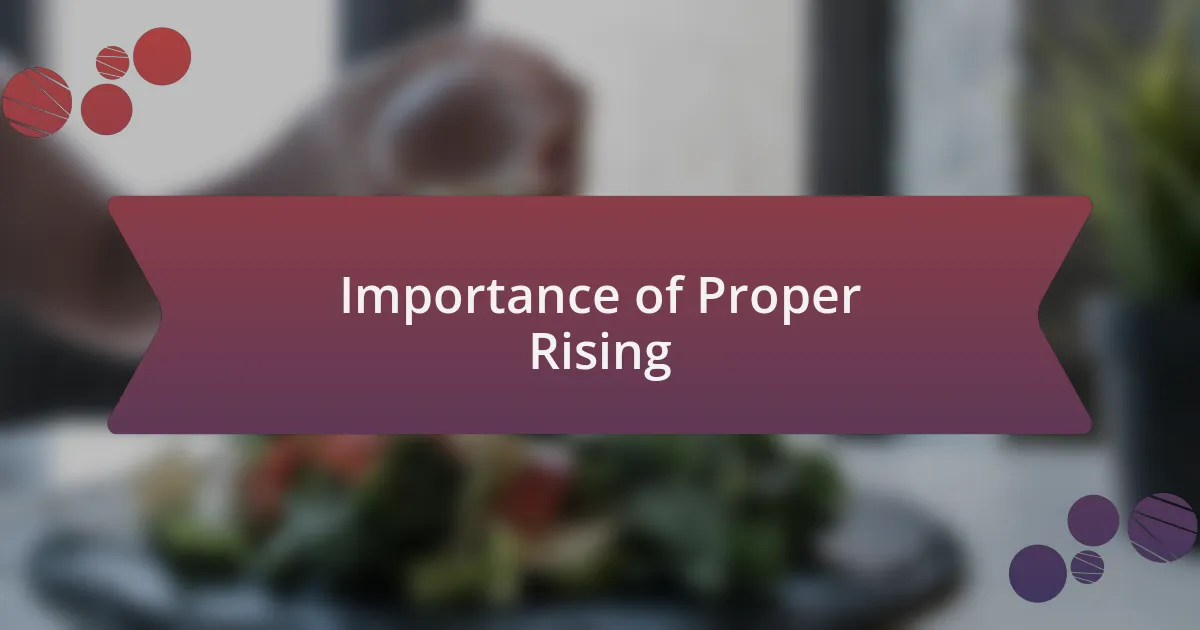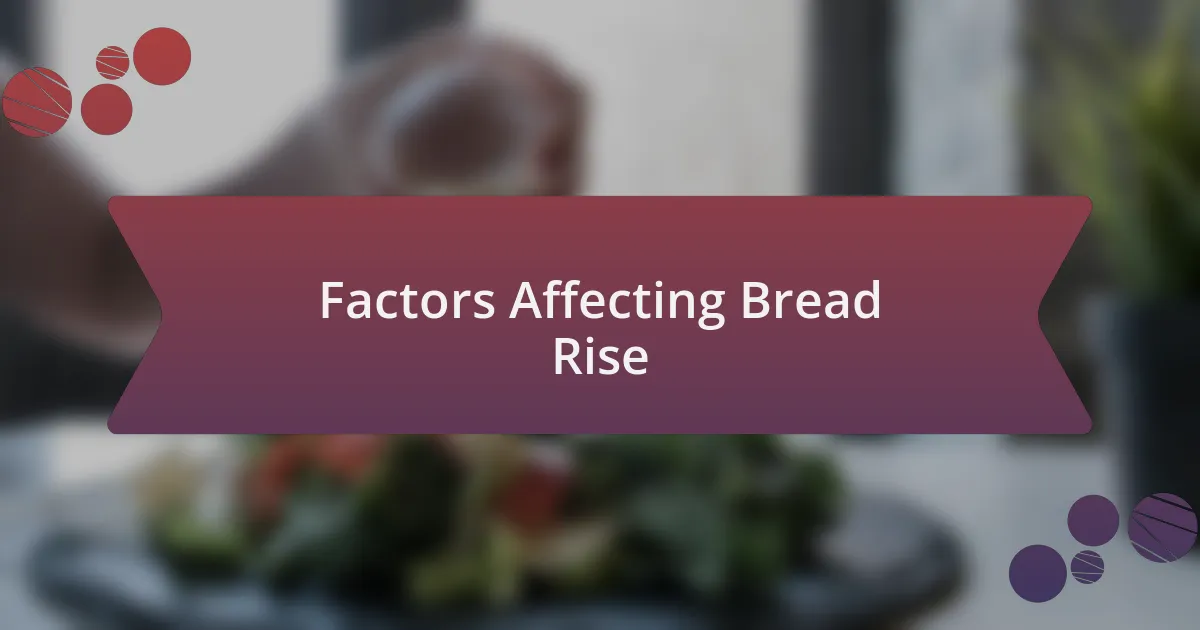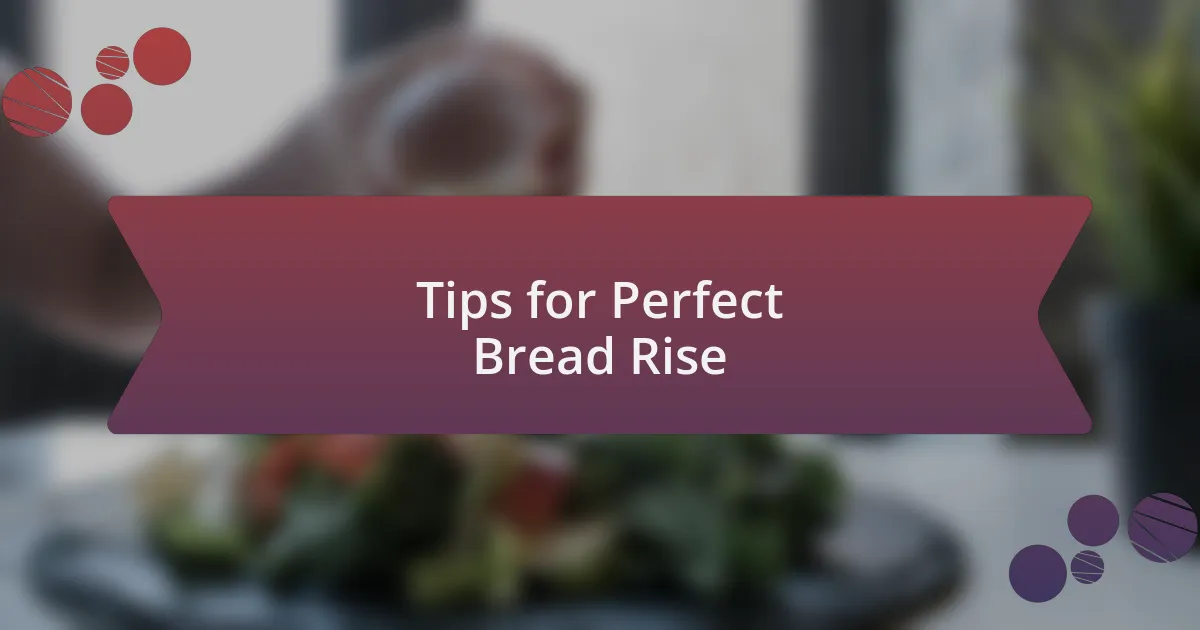Key takeaways:
- Bread rising, or fermentation, is essential for creating the airy texture in bread as yeast produces carbon dioxide gas.
- Proper rising enhances the texture and flavor of the bread; rushing can lead to dense, unsatisfactory loaves.
- Temperature, quality of ingredients, and active yeast are crucial factors that affect the rising process.
- Common mistakes include rushing the first rise, using outdated yeast, and over-kneading the dough.

What is Bread Rising
Bread rising, often referred to as fermentation, is the process where yeast consumes sugars and produces carbon dioxide gas. This reaction is essential for creating that delightful airy texture we love in our loaves. I remember the first time I witnessed my dough puffing up; it felt almost magical, as if the yeast was performing a little dance beneath the surface.
During the rising process, the dough transforms and develops flavor. The warmth of the kitchen, combined with that sweet smell of fermentation, is often a comforting reminder of home for many of us. Have you ever stood by your dough as it rises, feeling that anticipation build? It’s a simple yet profound moment that highlights the beauty of baking—what you invest in patience truly pays off.
There are various factors that can impact bread rising, such as temperature and humidity. I often find that a cozy environment helps, but too much heat can lead to a rapid rise that diminishes flavor. It’s fascinating how, with just a few adjustments, you can influence the dough’s development—almost like guiding a child’s growth with love and care.

Importance of Proper Rising
Proper rising is crucial to achieving the right texture and flavor in your bread. I recall the countless times I’ve rushed the rising process, only to end up with dense, disappointing loaves, leaving me to ponder, what was I thinking? This simple step allows the yeast to work its magic, creating those lovely air pockets that make every bite a delight.
The aroma wafting through the kitchen while dough rises can be enchanting, hinting at the delicious bread to come. I always find myself just a little giddy, wondering how such a humble mixture of flour, water, and yeast can transform into something so fragrant and warm. Without adequate rising, you’re not just missing out on texture—you’re also losing that beautiful complexity of flavor that develops during this essential stage.
Think about it: if we didn’t allow our dough to rise, we’d be eating something that resembles more of a brick than a loaf. I’ve learned the hard way that giving dough the time it needs is non-negotiable. It’s that blend of patience and care that truly turns simple ingredients into a loaf that not only looks good but tastes even better.

Factors Affecting Bread Rise
When it comes to bread rising, temperature plays a pivotal role. I remember one winter, turning up the heat in my kitchen, only to discover that my dough rose like a champion, showcasing its potential. On the flip side, I’ve also experienced the frustration of cold dough—my yeast just didn’t wake up! A warm environment kicks the yeast into action, so keeping an eye on the thermometer can make all the difference in the world.
Another critical factor is the yeast itself. Choosing between active dry yeast and instant yeast can feel overwhelming, but each has its quirks. I once opted for expired yeast out of sheer haste, and the result was a flat disappointment instead of a fluffy centerpiece. Fresh, lively yeast will ensure your dough rises like it should—always check the expiration date!
Finally, don’t overlook the quality of your ingredients. I recall a time when I switched to whole grain flour thinking it would be healthier, but I noticed that the bread required a bit more hydration to rise properly. That extra water made a world of difference! Each ingredient holds its weight, and understanding how they interact can elevate your bread game tremendously. How often do we stop to think about the impact of our choices in the kitchen?

Techniques for Effective Rising
Using the right technique can significantly enhance your bread’s rise. I’ve found that kneading isn’t just a workout for my arms; it’s also crucial for developing gluten, which helps trap air bubbles. There’s something satisfying about feeling the dough transform under my hands, and I usually give it a good 10 minutes. Have you ever felt the difference in texture before and after kneading? It’s like magic!
Another technique I swear by is the use of a proofing box or a warm oven for rising. One day, I accidentally turned my oven on to preheat and left my dough inside. When I discovered it later, the dough was practically bursting out of the bowl! This incident taught me just how important a consistent, warm environment can be for effective rising. I recommend finding a method to maintain that warmth—whether it’s a turned-off oven or a sunny windowsill.
Lastly, don’t underestimate the power of patience. I’ve had moments when I wanted to rush things, feeling that the dough was taking forever to double. But, trusting the process is crucial. I’ve learned that leaving the dough alone a little longer often leads to a better rise and a more flavorful loaf. How have you dealt with the temptation to rush your bread-making journey? The wait is worth it, I promise!

My Personal Rising Methods
In my experience, I’ve found that the temperature of the ingredients makes a world of difference in how my bread rises. When I use lukewarm water, it feels like I’m giving my yeast a cozy blanket to snuggle up in, allowing it to activate more efficiently. Have you ever noticed how a simple tweak in temperature can lead to a vastly different outcome? It’s fascinating!
Another method I’ve embraced is using a damp cloth over my dough as it rises. I remember one particularly dry winter when my dough was reluctant to expand. By covering it with a slightly moist cloth, I created a nurturing environment that encouraged the yeast to work its magic. I’ve since understood that a little humidity can go a long way in helping my bread achieve that perfect lift.
I also love to incorporate some gentle folding into my rising routine. After letting the dough sit for the first rise, I’ll take a moment to stretch and fold it a couple of times. It’s my way of reconnecting with the ingredients, and I often think of it as giving the dough a gentle pep talk. Have you tried this technique? It’s like telling the dough, “You’ve got this!” and encouraging it to rise even higher.

Common Mistakes to Avoid
Avoiding mistakes in bread rising is crucial for that delightful loaf we all desire. One major error I often see is rushing the first rise. I once impatiently shaped my dough too soon, eager for fresh bread, only to discover it didn’t have the airy texture I craved. Trust me, letting the dough rise until it has doubled in size is worth the wait.
Another common pitfall is neglecting to ensure your yeast is active and fresh. I learned this the hard way when I used outdated yeast and ended up with a dense doorstop instead of fluffy bread. Always check the expiration date, and if you’re unsure, a quick proofing in warm water with a sprinkle of sugar can confirm its readiness.
Finally, over-kneading dough can be a sneaky mistake. I remember the first time I excitedly kneaded my dough for what felt like ages, only to end up with a tough loaf. It’s better to knead just enough to bring the dough together and develop some elasticity. This way, you keep the bread light and tender – the way it’s meant to be!

Tips for Perfect Bread Rise
When it comes to achieving that perfect bread rise, temperature plays a vital role. I’ve found that my kitchen can range from cozy to chilly, affecting yeast activity. So, I’ve started warming my mixing bowl slightly by rinsing it with hot water beforehand. This simple trick not only boosts the dough’s initial rise but also keeps me from constantly adjusting the thermostat.
Another tip is to provide the right environment for rising. I remember placing my dough near a sunny window once; it was a disaster! Instead of a gentle warmth, my dough faced unyielding heat, leading to a collapsed rise. Now, I cover my bowl with a damp cloth and let it rise in a warm, draft-free area. It’s all about finding that sweet spot to encourage the dough to bloom.
Lastly, don’t rush the second rise, or what bakers like to call “the proof.” I’ve made this mistake more times than I’d like to admit, thinking the dough looks good enough to bake. Allow your shaped loaves to rest until they nearly double in size again. This extra time infuses the bread with a tempting lightness and that unmistakable airy structure. Trust me; it’s a lesson baked into every loaf!